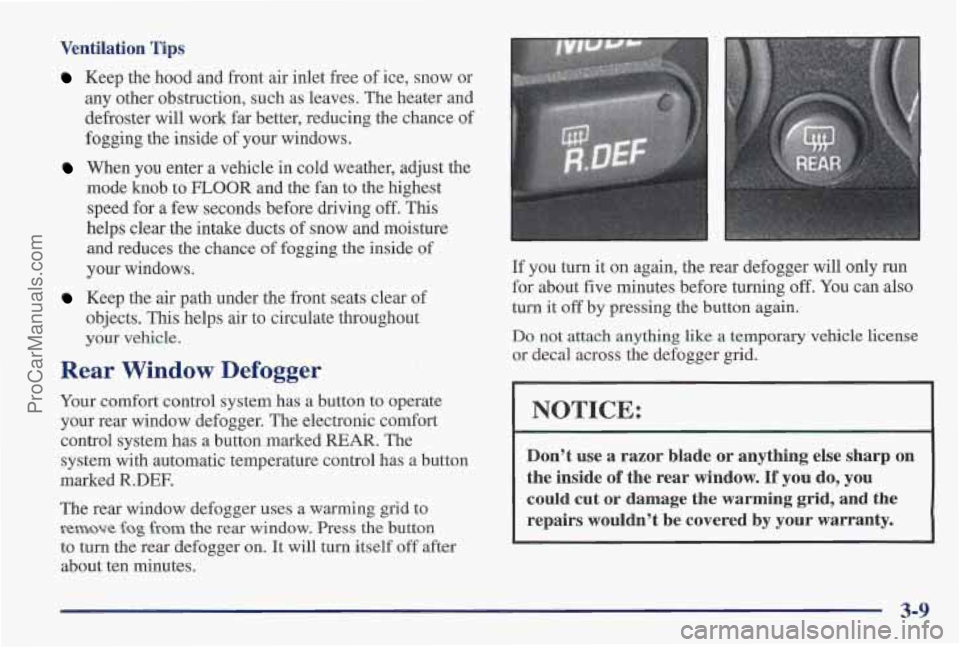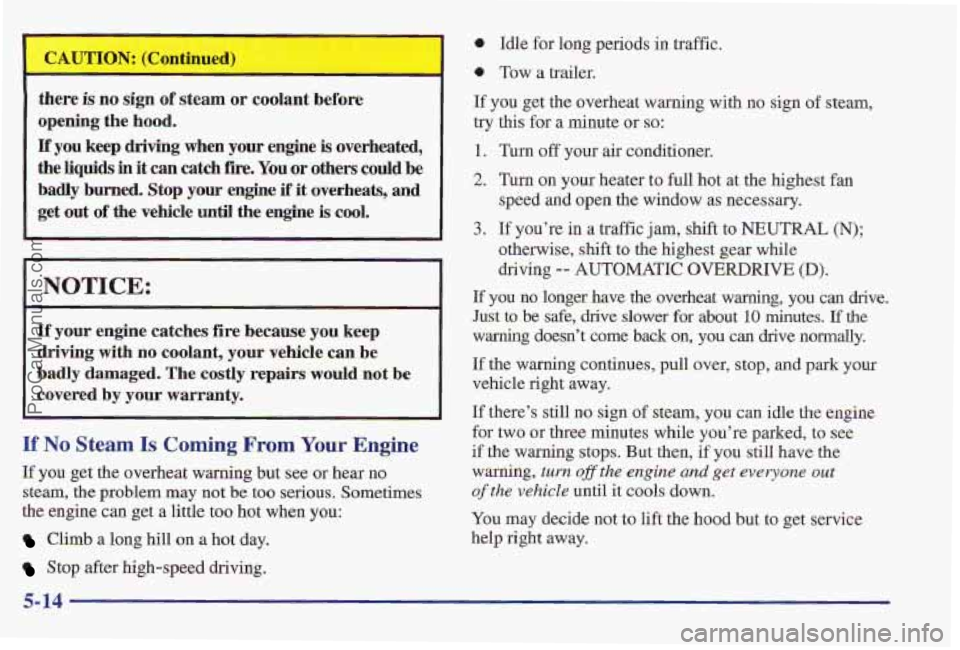1997 PONTIAC PONTIAC heater
[x] Cancel search: heaterPage 75 of 419

v Section 2 Features and Controls
Here you can learn about the many standard and optional features on your Pontiac, and information on starting,
shifting and braking. Also explained are the instrument panel and the warning systems that tell you if everything is
working properly
-- and what to do if you have a problem.
2-2
2-4
2-8
2- 10
2-12
2-15
2-15
2- 16
2-18
2-19
2-24
2-29
2-30
2-3 1
Important Information About Keys
Door Locks
Remote Keyless Entry Battery Replacement for RKE
Preventing Theft
of Your Vehicle
New Vehicle “Break-In”
Ignition Positions
Tips on Starting Your Engine
Using the Engine Coolant Heater
Automatic Transaxle Operation
Parking Brake Guidelines
Important Information on Engine Exhaust
Operation of Your Windows
Adjusting the Tilt Steering Wheel 2-32
2-33
2-33
2-35
2-3 8
2-39
2-40
2-5 3
2-54
2-62
2-64
2-78
2-83
Functions of the Multifunction Lever
How to Use the HighLow Beam
Headlamp Changer
Windshield Wipers and Fluid
Using Cruise Control
Exterior Lamps
Daytime Running Lamps
(DRL)
Interior Lamps
Rearview Mirrors
Storage Compartments
Instrument Panel Overview
All About Your Warning Lights and Gages
Driver Information Center
Head-Up Display
2-1
ProCarManuals.com
Page 92 of 419

Engine Coolant Heater (Option)
In very cold weather, 0°F (- 18 “C) or colder, the engine
coolant heater can help. You’ll get easier starting and
better €uel economy during engine warm-up. Usually,
the coolant heater should be plugged in a
minimum of
four hours prior to starting your vehicle.
To Use tl Coolant Heater
1. Turn off the engine.
2. Open the hood and unwrap the electrical cord.
3. Plug it into a normal, grounded 110-volt AC outlet.
Plugging the cord into an ungrounded outlet
could cause an electrical shock.
Also, the wrong
kind
of extension cord could overheat and cause
a fire. You could be seriously injured. Plug the
cord into a properly grounded three-prong
110-volt
AC outlet. If the cord won’t reach, use a
heavy-duty three-prong extension cord rated for
at least 15 amps.
4. Before starting the engine, be sure to unplug and store
the cord
as it was before to keep it away from moving
engine parts.
If you don’t, it could be damaged.
How long should you keep the coolant heater plugged
in? The answer depends on the outside temperature, the
kind of oil you have, and some other things, Instead of
trying to list everything here, we ask that you contact
your Pontiac dealer in the area where you’ll be parking
your vehicle. The dealer can give you the best advice for
that particular area.
2-18
ProCarManuals.com
Page 164 of 419

Heating
On cold days use FLOOR with the temperature knob all
the
way in the red area. The system will bring in outside
air, heat it and send
it to the floor ducts.
If your vehicle has an engine coolant heater, you can use
it to help your system provide warm air faster when it’s
cold outside
0°F (- 18 “C) or lower. An engine coolant
heater
warns the coolant your engine and heating
system use
to provide heat. See “Engine Coolant
Heater” in the Index.
Ventilation
For mild outside temperatures when little heating or
cooling is needed, use UPPER, with the AK button off,
to direct outside air through your vehicle. Your vehicle
also has the flow-through ventilation system described
later in this section.
Defogging and Defrosting
Your system has two settings for clearing the front and
side windows.
To defrost the windows quickly, use
DEFROST with the temperature knob all the way in the
red area. To warm passengers while keeping the
windows clean, use
DEFOG.
Air Conditioning with Automatic and
Auxiliary Temperature Control
(If Equipped)
With this system, you set a “desired cabin” temperature.
You can then either let the system automatically
control
airflow direction and amount (to maintain the desired
cabin temperature)
or you can manually adjust it. The
system works best
if you keep your windows closed
while using it.
3-4
ProCarManuals.com
Page 168 of 419

Heating
On cold days use LOWER. The system will bring in
outside air, heat it and send it to the floor ducts.
If your vehicle has an engine coolant heater, you can
use
it to help your system provide warm air faster when it’s
cold outside
0°F (- 18 O C) or lower. An engine coolant
heater warms the coolant your engine and heating
system use
to provide heat. See “Engine Coolant
Heater” in the Index.
Ventilation
For mild, outside temperatures when little heating or
cooling is needed, use UPPER with the A/C button off,
to direct outside air through your vehicle. Your vehicle
also
has the flow-through ventilation system described
later in this section.
Defogging and Defrosting
Your system has two settings for clearing the front and
side
windows, To defrost the windows quickly, use DEE
To warm passengers while keeping the windows clean,
use
DEFOG.
Ventilation System
r-
I’
Adjust the direction of airflow by moving the louvered vents.
Your vehicle’s flow-through ventilation system supplies
outsid’e air into the vehicle when it
is moving. Outside
air will also enter the vehicle when the air conditioning
fan
is running.
3-8
ProCarManuals.com
Page 169 of 419

Ventilation Tips
Keep the hood and front air inlet free of ice, snow or
any other obstruction, such as leaves. The heater and
defroster will work far better, reducing the chance of
fogging the inside of your windows.
When you enter a vehicle in cold weather, adjust the
mode knob to
FLOOR and the fan to the highest
speed for a few seconds before driving off. This
helps clear the intake ducts of snow and moisture
and reduces the chance
of fogging the inside of
your windows.
Keep the air path under the front seats clear of
objects. This helps air to circulate throughout
your vehicle.
Rear Window Defogger
Your comfort control system has a button to operate
your rear window defogger. The electronic comfort control system has a button marked
REAR. The
system with automatic temperature control has a button
marked
R.DEF.
The rear window defogger uses a warming grid to
K~~OW fog from the rear window. Press the button
to turn the rear defogger on. It will turn itself off after
about ten minutes.
If you turn it on again, the rear defogger will only run
for about five minutes before turning off.
You can also
turn it off by pressing the button again.
Do not attach anything like a temporary vehicle license
or decal across the defogger grid.
NOTICE:
Don’t use a razor blade or anything else sharp on
the inside
of the rear window. If you do, you
could cut or damage the warming grid, and the
repairs wouldn’t be covered by
your warranty.
3-9
ProCarManuals.com
Page 223 of 419

Run your engine only as long as you must. This saves
fuel. When you run the engine, make it
go a little faster
than just idle. That
is, push the accelerator slightly. This
uses less fuel for the heat that you get and it keeps the
battery charged. You will need a well-charged battery
to restart the vehicle, and possibly for signaling later on
with your headlamps. Let the heater run for a while.
Then, shut the engine off and close the window almost
all the way to preserve the heat. Start the engine again
and repeat this only when you feel really uncomfortable
from the cold. But do it as little as possible. Preserve the
fuel as long as
you can. To help keep warm, you can get
out of the vehicle and do some fairly vigorous exercises
every half hour or
so until help comes.
Loading Your Vehicle
/@ OCCUPANTS
VEHICLE CAP. WT.
TIRE-LOADING INFORMATION
FRT. CTR.
RR. TOTAL LBS. KG
~-
MAX. LOADING & GVWR SAME AS VEHICLE
CAPACITY
WEIGHT XXX COLD TIRE
TIRE
SIZE SPEED PRESSURE
RTG PSI/KPa
FRT.
RR.
SPA.
IF TIRES ARE HOT, ADD 4PS1/28KPa
SEE OWNER'S MANUAL FOR ADDITIONAL
INFORMATION
Two labels on your vehicle show how much weight it
may properly
carry. The Tire-Loading Information label
is on the inside of the trunk lid. The label tells you the
proper size, speed rating and recommended inflation
pressures for the tires on your vehicle.
It also gives you
important information about the number of people that
can be in your vehicle and the total weight you can
carry. This weight is called the vehicle capacity weight
and includes the
weight of all occupants, cargo and all
nonfactory-installed options.
ProCarManuals.com
Page 248 of 419

tnere is no sign of steam or coolant before
opening the hood.
If you keep driving when your engine is overheated,
the
liquids in it can catch fire. You or others could be
badly burned. Stop your engine if it overheats, and
get out
of the vehicle until the engine is cool.
I NOTICE:
If your engine catches fire because you keep
driving
with no coolant, your vehicle can be
badly damaged. The costly repairs would not
be
covered by your warranty.
If No Steam Is Coming From Your Engine
If you get the overheat warning but see or hear no
steam, the problem may not be too serious. Sometimes
the engine can get a little
too hot when you:
Climb a long hill on a hot day.
Stop after high-speed driving. Idle for long
periods in traffic.
* Tow a trailer.
If you get the overheat warning with no sign of steam,
try this for a minute or so:
1. Turn off your air conditioner.
2. Turn on your heater to full hot at the highest fan
speed and open the window as necessary.
3. If you’re in a traffic jam, shift to NEUTRAL (N);
otherwise, shift to the highest gear while
driving
e- AUTOMATIC OVERDRIVE (D).
If you no longer have the overheat warning, you can dnve.
Just to be safe, drive slower for about 10 minutes. If the
warning doesn’t come back on, you can drive normally.
If the warning continues, pull over, stop, and park your
vehicle right away.
If there’s still no sign of steam, you can idle the engine
for two or three minutes while you’re parked, to see
if the warning stops. But then, if you still have the
warning, turn off the engine and get everyone out
of the vehicle until it cools down.
You may decide not to lift the hood but to get service
help right away.
5-14
ProCarManuals.com
Page 250 of 419

I
An electric fan under the hood can start up even
when the engine is not running and can injure
you. Keep hands, clothing
and tools away from
any underhood electric fan.
If the coolant inside the coolant recovery tank is boiling,
don’t
do anything else until it cools down.
The coolant level should be at or above the COLD mark
on the overflow hose in the coolant recovery bottle. To
check the coolant level remove the cap on the coolant
recovery bottle. Make sure to check that the coolant
level is up to the
COLD fill level on the hose attached to
the cap.
If it isn’t, you may have a leak in the radiator
hoses, heater hoses, radiator, water
pump or somewhere
else in the cooling system.
Heater and radiator hoses, a i other engine
parts, can
be very hot. Don’t touch them. If you
do, you can be burned.
Don’t run the engine if there is a leak. If you run
the engine,
it could lose all coolant. That could
cause
an engine fire, and you could be burned.
Get any leak fixed before you drive the vehicle.
5-16
ProCarManuals.com